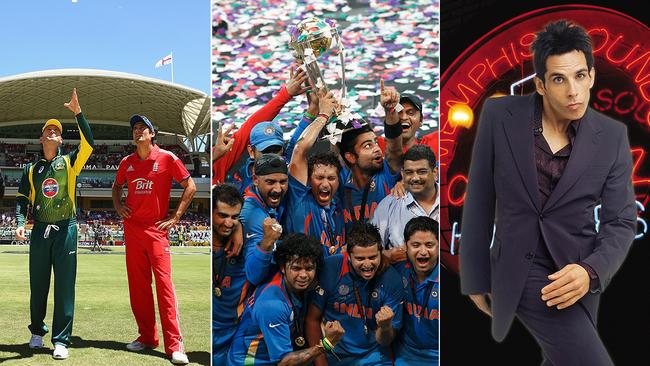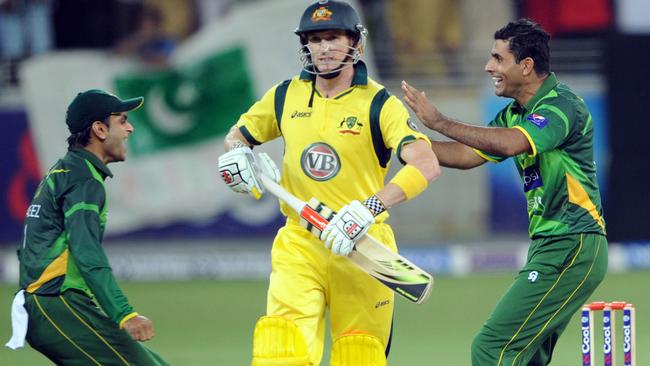Cricket World Cup 2015: how winner should be chosen if final ends in a tie
THE ICC wants the World Cup trophy shared if the final is a tie, but we’ve come up with 10 other ways a winner could be decided.

Cricket
Don't miss out on the headlines from Cricket. Followed categories will be added to My News.
THE International Cricket Council has revealed a tie in the World Cup final would result in both teams being declared winners.
It’s a decision that has created plenty of debate around the cricketing world, with many insisting the sport’s marquee tournament deserves to have an outright winner.
But just how should the winner be decided if indeed scores are level after 50 overs each?
We’ve come up with a few solutions – some realistic, some perhaps a little farfetched – to solve one of one-day cricket’s biggest problems.
BOUNDARIES
Simple yet effective. The team who hits the most fours during their innings is the winner. If both teams score the same number of fours, then sixes could be used as a tie-breaker.
This solution may even add some spice to the mundane middle overs that are generally populated by singles and sweeping fieldsmen.

A SUPER OVER
It’s the penalty shootout of cricket and has already been used to decide the result of major matches at the Twenty20 World Cup.
Giving a team one over to score as many runs as possible would be sure to upset the purists but at least it would use a bat and a ball to decide the winner of cricket’s biggest tournament.

FAN VOTE
The sporting experience is increasingly reliant on bringing the fans closer to the action and it’s the fans’ game after all, so why can’t they have an impact on the result?
Anyone who has tuned into the Australian Open tennis broadcast has had Fango rammed down their throats, so fan interaction during a sporting event is not a foreign concept.
After the final ball has been bowled fans could be called upon to vote via their preferred social platform and the winning team would be announced via the third umpire or Shane Warne’s Twitter account.
A TOSS OF THE COIN
No sport places as much emphasis on the coin toss as cricket, so why not take that to the next level by using the timeworn tradition to truly decide the winner of the match.
In fact it wouldn’t be the first time a coin toss has decided the outcome of a match at a major global tournament – in September Kuwait advanced to the cricket quarter-finals at the Asian Games after their match against Maldives was washed out.
WICKETS
It makes sense that the team who can make the runs and lose as little wickets as possible in the process should be the winner of the match.
While a game of one-day cricket is traditionally awarded to the team who makes the most runs, this idea flips the ledger by rewarding the team who takes the most wickets.
A WALK-OFF
It had disastrous consequences for noted cricket aficionado and lover of investigatory journalism Derek Zoolander, but a ‘walk-off’ could be a handy way of determining the World Cup winner.
England would do well not to choose Stuart Broad as their walker.
PAST PERFORMANCES
This is the method that will be used to choose a winner if any of the quarter-finals or semi-finals end in a tie, with the team that finished highest during the group stage advancing to the next game.
It rewards recent form and places a greater emphasis on group matches that could otherwise be deemed meaningless, so is definitely one of the fairest ways of determining an overall winner.
ANIMAL LOTTO
Paul the Octopus shot to fame thanks to his ability to predict - with alarming accuracy - Germany’s progression through the 2010 football World Cup, so some form of animal intervention is the logical answer to this issue.
Unfortunately Paul is unavailable, as he became acquainted with salt and pepper in October of 2010, but a mascot is yet to be named for the tournament and we think ‘Aussie the cricket’ would be a suitable choice.
Aussie would make his prediction after the toss and in the event of a tie, his pre-match selection would be crowned the winner.

A BIG BASH – LITERALLY
Limited-overs cricket is all about the batsmen these days, and with bats bigger and heavier than ever, clearing the boundary rope is hardly a challenge for most willow-wielders.
So let’s put these flat track bullies to the ultimate test by seeing just how far they can really hit the ball.
The technology is available thanks to television broadcasters, and the format could be relatively simple. Each team selects one batsman who has six chances to hit the ball as far as he possibly can.
The player that hits the ball the furthest wins the title of cricket’s biggest hitter. Oh, and he also wins the World Cup.
THE BASEKETBALL SOLUTION
Of course, if all else fails the ICC could just borrow an idea from the great American sport of ‘BASEketball’.
Originally published as Cricket World Cup 2015: how winner should be chosen if final ends in a tie


